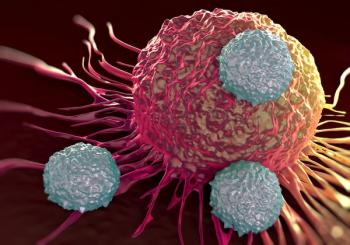
- ONCOLOGY Vol 15 No 11
- Volume 15
- Issue 11
European Experience With Oral Solution and Intravenous Itraconazole
The availability of an improved oral solution and an intravenous (IV) formulation of itraconazole (Sporanox) promises to have an effect on prevention and treatment of fungal infection in immunocompromised patients. Use of itraconazole in neutropenic patients with hematologic malignancies has been evaluated in a number of European studies. Treatment with IV followed by oral itraconazole resulted in response or stable disease in two-thirds of patients with invasive pulmonary aspergillosis. Empiric treatment with IV followed by oral solution itraconazole was at least as effective as, and significantly less toxic than, amphotericin B. Several studies of oral solution prophylaxis indicate effectiveness in prevention of fungal infection. Oral solution and IV itraconazole are useful in a variety of situations in prophylaxis, empiric therapy, and treatment of probable/confirmed infection. Itraconazole exhibits a broad spectrum of activity against Aspergillus and Candida species. It has potential advantages over fluconazole (Diflucan), which does not exhibit in vitro activity against Aspergillus and most non-albicans Candida species, and amphotericin B, which is associated with a high incidence of toxicity. Aggressive use of itraconazole and amphotericin B preparations in treatment of fungal infection at Royal Free Hospital may have reduced mortality associated with aspergillosis. [ONCOLOGY 15(Suppl 9):27-32, 2001]
ABSTRACT: The availability of an improved oral solution and an intravenous (IV) formulation of itraconazole (Sporanox) promises to have an effect on prevention and treatment of fungal infection in immunocompromised patients. Use of itraconazole in neutropenic patients with hematologic malignancies has been evaluated in a number of European studies. Treatment with IV followed by oral itraconazole resulted in response or stable disease in two-thirds of patients with invasive pulmonary aspergillosis. Empiric treatment with IV followed by oral solution itraconazole was at least as effective as, and significantly less toxic than, amphotericin B. Several studies of oral solution prophylaxis indicate effectiveness in prevention of fungal infection. Oral solution and IV itraconazole are useful in a variety of situations in prophylaxis, empiric therapy, and treatment of probable/confirmed infection. Itraconazole exhibits a broad spectrum of activity against Aspergillus and Candida species. It has potential advantages over fluconazole (Diflucan), which does not exhibit in vitro activity against Aspergillus and most non-albicans Candida species, and amphotericin B, which is associated with a high incidence of toxicity. Aggressive use of itraconazole and amphotericin B preparations in treatment of fungal infection at Royal Free Hospital may have reduced mortality associated with aspergillosis. [ONCOLOGY 15(Suppl 9):27-32, 2001]
Efficacy and Safety Study
In a multicenter, open-label, single- group study, Caillot and colleagues[1]evaluated the efficacy and safety of itraconazole in 31 immunocompromised adultpatients with invasive pulmonary aspergillosis. Of the 31 patients participatingin the study, 90% had hematologic malignancy, 7% had graft-vs-host disease, and3% had AIDS; 61% of the patients were neutropenic.
The study also assessed plasma levels of itraconazole and the activemetabolite hydroxy-itraconazole to determine the pharmacokinetics of theintravenous (IV)/oral capsule dosing regimen that was used.
Aspergillosis was diagnosed on the basis of positive tissue biopsy, cultureor direct examination of percutaneous lung aspirate, presence of new orprogressive infiltrates on x-ray or computed tomography (CT) with positivesputum or bronchoalveolar lavage or positive nasal swab (in neutropenicpatients), or when bronchoscopy/lavage and CT scans showed typical halo or aircrescent signs.
Dosage and Response
Treatment consisted of itraconazole IV at 200 mg twice daily for 4 days and200 mg once daily for 12 days, followed by oral itraconazole capsules 200 mgtwice daily for 12 weeks. Outcomes were assessed at day 14 and at 14 weeks. All31 patients received IV itraconazole for a median of 14 days, and 26 receivedoral itraconazole for a median of 78.5 days.
Response (defined as resolution or major improvement in all signs andsymptoms) at day 14 was observed in 38% of patients, with response or stabledisease being observed in 81%. By the end of study treatment, response wasobserved in 48% of patients, with response or stable disease being observed in68%.
Plasma Drug Concentrations
Figure 1 shows plasma drug concentrations, assessed by high-performanceliquid chromatography with ultraviolet detection, during the course of theCaillot study. Therapeutic trough plasma levels (> 250 ng/mL) were obtainedin 91% of the patients within 2 days of IV treatment and in all patients within1 week of IV treatment. Therapeutic levels exceeding the minimum effectiveconcentration were maintained after changing from IV to oral treatment. Intotal, adverse events were reported in 42% of patients during IV treatment and35% during oral treatment. Treatment was discontinued due to adverse effects inseven patients; two related to the IV preparation (rigors and rashes) and fiverelated to the oral preparation (gastrointestinal side effects).
Empiric Therapy in Neutropenic Patients
DeBeule and colleagues[2] performed a multicenter, open-label, randomizedstudy to assess the pharmacokinetics of an IV/oral solution itraconazole regimenand to compare the effects of itraconazole and amphotericin B as empiric therapyfor fever of unknown origin in neutropenic patients with hematologicmalignancies.
Methods
The study enrolled a total of 394 adults with hematologic malignancies withneutropenia (absolute neutrophil count < 500,000 × 10³/L) expected to last for 7days and persistent fever (> 38°C) despite 3 to 7 days of broad-spectrumantimicrobial treatment. A total of 384 patients received at least one dose ofstudy medication and were included for safety analysis. Evaluation of efficacywas based on an intention to treat 360 randomized patients who satisfied thefull inclusion/exclusion criteria.
Underlying diagnoses were similar in the two treatment groups, with 56% ofpatients in each having acute myelogenous leukemia (AML). The treatment groupswere well-matched for risk factors, with similar proportions of patientsundergoing first treatment or having first or second or subsequent relapse,similar proportions undergoing autologous bone marrow transplantation (BMT) orperipheral blood stem cell transplantation, and similar proportions usingcorticosteroids, exhibiting fungal colonization of the digestive tract, andexhibiting mucositis. The median duration of neutropenia was approximately 9days in both groups.
Dosage and Response
Treatments consisted of itraconazole IV 200 mg twice daily for 2 days and 200mg once daily for 5 to 12 days followed by oral solution 400 mg once daily fromday 15 to day 28 or amphotericin B IV at 0.7 to 1.0 mg/kg/d for 28 days.
Patients in the itraconazole group received IV treatment for a median of 8.5days; 65 patients switched to oral itraconazole for a median of 7 days after amedian of 9 days of IV treatment. Patients in the amphotericin B group receivedIV amphotericin B for a median of 7 days; the mean amphotericin B dose was 0.71mg/kg/d.
Treatment response was defined as absence of fever for 3 days and a recoveryfrom neutropenia for a minimum of 2 consecutive days. Failure was defined asdocumented deep fungal infection or highly suggestive CT findings, documentedbacterial or viral infection responsible for fever, death due to any causewithin 3 days of starting study treatment, persistent fever at the end ofneutropenia or at day 28, persistence of signs and symptoms of fungal infectionirrespective of presence of fever, fever requiring a change in the antifungalregimen, or discontinuation of study medication due to poor tolerance.
Outcomes
In total, 24 (13%) of the itraconazole patients and 46 (25%) of theamphotericin B patients were considered unevaluable on the basis of receivingtreatment for 3 or fewer days. Failure occurred in 72 (39%) and 70 (38%) of theintraconazole and amphotericin B recipients, respectively, and response occurredin 48% and 38%, respectively. It was calculated that itraconazole was at leastas effective as amphotericin B treatment (P = .001, Fleiss test).
A further analysis based on the composite end point[3] indicated response in53% of the itraconazole recipients and in 46% of the amphotericin B recipients (P = .047, Fleiss test).
Severe adverse events occurred in 19% of the itraconazole group and 34% ofthe amphotericin B group (P = .001); 19% and 38% (P = .001), respectively,withdrew from treatment due to adverse effects. Adverse events consideredrelated to study therapy occurred in 5% of the itraconazole group and in 54% ofthe amphotericin B group (P < .001). Nephrotoxicity (defined as serumcreatinine > 2 times baseline level) occurred in 5% and 24% (P < .001),respectively; mean creatinine clearance in the treatment groups is shown in Figure 2.
Pharmacokinetic evaluation showed that therapeutic plasma itraconazole levelswere achieved in 97% of patients within 3 days of starting treatment. As shownin Figure 3, mean trough plasma concentrations increased through day 15 and weresomewhat reduced after initiation of oral dosing but remained well over minimumtherapeutic levels.
Prophylaxis With Itraconazole Oral Solution
A number of trials have assessed the effects of oral solution itraconazole inprophylaxis of fungal infection.
Itraconazole vs Placebo
In a randomized, double-blind trial in 405 neutropenic patients withhematologic malignancies, Menichetti and colleagues[4] found that itraconazoleat 2.5 mg/kg twice daily was associated with significant reductions comparedwith placebo in proven and suspected deep fungal infection (24% vs 33%) and Candida fungemia (0.5% vs 4%) and a borderline significant reduction in deathdue to candidemia (no patients vs four patients).
Aspergillosis was observed in four itraconazole recipients and in one placeborecipient, with one patient in each group dying. Adverse effects causingtreatment interruption occurred in 18% of the itraconazole group and in 13% ofthe placebo group. Pharmacokinetic data indicated that plasma itraconazolelevels were > 250 ng/mL in 53% of samples before day 12 and in 86% of samplesafter day 12.
Itraconazole vs Fluconazole
A randomized trial compared itraconazole at 2.5 mg/kg twice daily (n = 288)and oral fluconazole (Diflucan) at 100 mg/d (n = 293) in neutropenic patientswith hematologic malignancies, including patients undergoing allogeneic BMT.Morgenstern and colleagues[5] found that itraconazole was associated with anumeric reduction in systemic aspergillosis (0 cases vs 4 cases) and death fromfungal infection (0 vs 4 cases) with the frequencies of C albicans infection (1vs 0 cases) and non-albicans infections (0 vs 2 cases) being comparable. Use ofempiric amphotericin B was significantly more common in the fluconazole group(58 vs 39 patients).
Drug level sampling showed that trough itraconazole levels at week 1 were> 250 ng/mL and > 500 ng/mL in 76% and 68% of patients, respectively; atweek 3 the levels were > 250 ng/mL and > 500 ng/mL in 86% and 85% ofpatients, respectively.
Itraconazole vs Amphotericin B
A randomized double-blind comparison of oral solution itraconazole (n = 281)with oral amphotericin B (n = 276) performed by Harousseau and colleagues[6] inpatients with hematologic malignancies, including patients undergoing BMT, wasterminated prematurely because the expected incidence of aspergillosis was notreached. When the trial was stopped, systemic aspergillosis had occurred in fiveitraconazole patients and nine amphotericin B patients, with death due tosystemic fungal infection occurring in one and five patients, respectively.Empiric IV amphotericin B was used in 90 and 102 patients, respectively (nosignificant differences).
Itraconazole in a Pediatric Population
Itraconazole oral solution prophylaxis has also been examined in a pediatrictransplant population (n = 103), most of whom were undergoing allogeneic stemcell transplantation.[7]
Itraconazole at 5 mg/kg/d was given in either one or two daily doses, and wasintended to be started 7 days prior to neutropenia. No systemic fungalinfections were observed; one case of esophageal candidiasis was detected.
A total of 26 patients received empiric amphotericin B. In all, 46% of thepatients completed the treatment course; the majority of patients whodiscontinued treatment had mucositis. Adverse events, including vomiting,abdominal pain, rash, and increased liver function tests, occurred in 18%. Sevenpatients had convulsions considered unrelated to itraconazole.
Reduced Candida and Aspergillus Infections
An overview of prophylactic studies of oral solution itraconazole indicatesthat proven systemic Candida infection occurred in rare instances, as didsystemic Aspergillus infection.
These findings compare well with rates of proven systemic fungal infectionobserved in fluconazole prophylaxis studies: 2.6% (vs 2.7% with oralamphotericin B) in a study in patients with acute leukemia, 2.1% (vs 8.4% withpolyene treatment) in a pediatric study, 2.8% (vs 15.8% with placebo) inallogeneic BMT patients (Goodman et al[8]), and 7% (vs 18% with placebo) inallogeneic or autologous BMT patients (Slavin et al[9]).
Rates of noncompliance with oral solution itraconazole regimens are 20% to40%, including high noncompliance rates in patients with mucositis.Pharmacokinetic data indicate that 70% or more of patients have good plasma troughdrug levels at 1 week. Additional data are needed on use of the formulation inhigher-risk patientseg, patients undergoing allogeneic stem celltransplantation.
Switching From IV to Oral Regimens
With regard to the potential for switching between IV and oral solutiontreatment in prophylaxis, the empiric and treatment studies discussedearlier[1,2] have indicated that the IV to oral switch results in themaintenance of adequate plasma trough levels. Prentice and colleagues[10] haveshown that switching from oral solution to IV treatment is also feasible interms of maintaining plasma drug levels in chemotherapy/transplantation patients(Figure 4).
The ability to switch between treatment modalities offers some obviousbenefits that can be worked into treatment strategies. For example, in stem celltransplant patients, IV treatment can be used during the period of mucositis,with treatment being switched to oral solution at resolution of mucositis priorto discharge. Some units in the United Kingdom have adopted a routine practiceof administering IV loading doses for 2 days on admission and switching to oraltreatment thereafter; since enteral feeding is replacing parenteral nutrition inmany units, oral solution can be given via a nasogastric tube.
Switching from oral to IV treatment may be contemplated in a number ofsituations in patients considered at high risk of developing systemic fungalinfection, including secondary prophylaxis, cases of colonization duringmucositis following stem cell transplantation, cases of prolonged neutropenia inwhich noncompliance with oral solution treatment may be an issue (or in anycases of de facto noncompliance), and in the small number of cases in whichabsorption of oral drug may be a problem (eg, in cases in which high-dosesteroid treatment is used in gastrointestinal tract graft-vs-host disease).
Intravenous itraconazole has been used in a variety of situations in clinicalpractice in the United Kingdom, including use in cases of toxicity ofconventional or liposomal amphotericin B (AmBisome), in prophylaxis in high-riskpatients (eg, those with previous aspergillosis or non-albicans candidiasis orthose with mucositis), in patients noncompliant with oral solution treatment,and in settings in which cost of treatment is an issue, as well as being used asprimary treatment in place of or in addition to liposomal amphotericin B.
Empiric Therapy With Oral Solution Itraconazole Prophylaxis
Rather than adopting a protocol for universal change to IV amphotericin B orliposomal amphotericin B in patients requiring empiric therapy while receivingoral solution itraconazole prophylaxis, we have adopted a risk-based approach totreatment. For low-risk patients, oral solution itraconazole may be continuedwith monitoring of plasma drug levels or treatment may be switched to IVitraconazole. We have also used liposomal amphotericin B at 1 mg/kg in suchpatients on the basis of a study[11] indicating equivalence of this dosage withconventional amphotericin B treatment. In high-risk patients, treatment isswitched to IV amphotericin B or liposomal amphotericin B at 3 mg/kg. (High-riskis defined here as allogeneic stem cell transplantation recipients, persons withexpected neutro- penia of more than 2 weeks’ duration, and those with fungalcolonization.) Issues remain regarding treatment alternatives in patients who donot exhibit resolution of fever within 96 hours of starting first-line empirictreatment.
Drug Interactions
Vincristine
Serious drug interactions have been observed in patients receivingitraconazole and vincristine. In a report[12] involving 14 acute lymphaticleukemia (ALL) patients receiving itraconazole, 4 demonstrated significantneurotoxicity after one or two vincristine doses, including 3 with paresthesiaand weakness, 2 with ileus, and 1 with laryngeal nerve paresis requiringventilation; fits and somnolence have also been observed.
It is unclear whether the drug interaction is due to cytochrome P450inhibition by itraconazole or MDR (multiple drug resistance) blockade resultingin increased intracellular vincristine concentrations or whether an effect inMDR blockade might result in interactions with other cytotoxic agents (eg,daunorubicin [DaunoXome]).
We currently avoid use of itraconazole in patients with ALL and otherpatients where vincristine is being administered. It remains unclear whether anitraconazole-free period during vincristine administration would permitavoidance of such an interaction.
Cyclosporine
An interaction between itraconazole and cyclosporine resulting in increasedplasma cyclosporine levels and associated toxicity (renal toxicity, fluidretention, hypertension, fits, and hemolytic uremic syndrome-thromboticthrombocytopenic purpura [HUS-TTP]) has also been recognized, with onereport[13] of a mean cyclosporine dose reduction of 56% being required in solidorgan transplant recipients.
Some centers initiate cyclosporine treatment at 2.5 mg/kg twice daily; ourprotocol is to begin treatment at 1.5 mg/kg twice daily, and we have observed notoxicities resulting from a drug interaction since we started to useitraconazole and have found no need to increase the cyclosporine dose whenitraconazole is withdrawn at 3 to 6 months (since cyclosporine withdrawal isusually underway at this stage).
Other Agents
In hematology patients, other potential drug interactions that need to beconsidered include reduced itraconazole bioavailability with rifampin, isoniazid,phenytoin (Dilantin), and carbamazepine and itraconazole potentiation ofmidazolam (Versed), warfarin (Coumadin), HIV protease inhibitors, calciumchannel blockers, busulfan (Busulfex, Myleran), methylprednisone,hydroxymethylglutaryl coenzyme A reductase inhibitors, and terfenadine (Triludan).
1999 Fungal Audit at Royal Free Hospital
Of more than 300 patient episodes of neutropenia (including 70 stem celltransplantation patientsapproximately 60 allogeneic transplant recipients) inthe tertiary referral center of Royal Free Hospital, there were 7proven/probable systemic fungal infections in 1999. These consisted of a proven A fumigatus sinus infection, probable pulmonary A fumigatus infection, andinfections with Fusarium, Absidia, C krusei, C glabrata, and Rhodotorula. Inaddition, there were eight possible pulmonary aspergillosis cases diagnosed onthe basis of CT findings. Of these 15 cases, 11 occurred in referred foreignpatients, 12 were in patients with the most advanced stage of acute leukemia,and 7 were in patients undergoing stem cell transplantation.
Of 10 patients with possible or probable/proven aspergillosis, prophylaxishad consisted of oral solution itraconazole in 5, with IV itraconazole,fluconazole, and amphotericin B in one each, with one patient receiving noprophylaxis. Treatment in these patients consisted of amphotericin B in four,itraconazole plus amphotericin B in four, itraconazole in one, and amphotericinB, itraconazole, and voriconazole in one, with GM-CSF (granulocyte macrophagecolony-stimulating factor [Leukine]) being used in eight. Treatment resulted inresolution of infection in six patients, improvement in three, and progressionin one. One of the four deaths among these 10 patients was due to invasivefungal infection.
Conclusion
Although these data do not constitute hard evidence of improvement inprevention and treatment of fungal infection, they are suggestive that theaggressive protocols we have adopted have altered the natural history of diseaseand may account for the reduced mortality associated with aspergillosis that weare currently observing.
References:
1. Caillot D, Basaris H, Seifert WF, et al: Efficacy, safety, andpharmacokinetics of intravenous followed by oral itraconazole in patients withinvasive pulmonary aspergillosis. Program and abstracts of the 39th InterscienceConference on Antimicrobial Agents and Chemotherapy; September 26-29, 1999; SanFrancisco. Abstract 1646.
2. De Beule KL, Boogaerts, M, Bow EJ, et al: Pharmacokinetics of intravenousitraconazole (Itr) and Itr oral solution given as empirical therapy forpersistent fever in neutropenic patients with hematologic malignancies. Programand abstracts of the 39th Interscience Conference on Antimicrobial Agents andChemotherapy; September 26-29, 1999; San Francisco. Abstract 1193.
3. Walsh TJ, Finberg RW, Arndt C, et al: Liposomal amphotericin B forempirical therapy in patients with persistent fever and neutropenia. NationalInstitute of Allergy and Infectious Diseases Mycoses Study Group. N Engl J Med11:764-771, 1999.
4. Menichetti F, Del Favero A, Martino P, et al: Itraconazole oral solutionas prophylaxis for fungal infections in neutropenic patients with hematologicmalignancies: A randomized, placebo-controlled, double-blind, multicenter trial.Clin Infect Dis 28:250-255, 1999.
5. Morgenstern GR, Prentice AG, Prentice HG, et al: A randomized controlledtrial of itraconazole vs fluconazole for the prevention of fungal infections inpatients with haematological malignancies. U. K. Multicentre AntifungalProphylaxis Study Group. Br J Haematol 105:901-911, 1999.
6. Harousseau JL, Dekker A, Stamatoullas A, et al: Prophylaxis of fungalinfections in hematological malignancies: A double blind trial comparingitraconazole solution to amphotericin B capsules. Blood 92 (suppl 1): 3202a,1998.
7. Foot ABM, Veys PA, Gibson BES: Itraconazole oral solution as antifungalprophylaxis in children undergoing stem cell transplantation or intensivechemotherapy for hematological disorders. Bone Marrow Transplant 24:1089-1093,1999.
8. Goodman JL, Winston DJ, Greenfield RA, et al: A controlled trial offluconazole to prevent fungal infections in patients undergoing bone marrowtransplantation. N Engl J Med 326:845-851, 1992.
9. Slavin MA, Osborne B, Adams R, et al: Efficacy and safety of fluconazoleprophylaxis for fungal infections after marrow transplantationA prospective,randomized, double-blind study. J Infect Dis 171:1545-1552, 1995.
10. Prentice AG, Copplestone JA, Hamon MD, et al: Intravenous itraconazolecan replace oral solution in Aspergillus prophylaxis: Pharmacokinetic data frompatients treated for hematological malignancies. Br J Hematol 108 (suppl 1):68,2000.
11. Prentice HG, Hann IM, Herbrecht R, et al: A randomized comparison ofliposomal vs conventional amphotericin B for the treatment of pyrexis of unknownorigin in neutropenic patients. Br J Hematol 98:711-718, 1997.
12. Bohme A, Ganser A, Heolzer D: Aggravation of vincristine-inducedneurotoxicity by itraconazole in the treatment of adult ALL. Ann Hematol71(6):311-312, 1995.
13. Kramer MR, Marshall SE, Denning DW, et al: Cyclosporine and itraconazoleinteraction in heart and lung transplant recipients. Ann Intern Med113(4):327-329, 1990.
Articles in this issue
about 24 years ago
Management of Pressure Ulcersabout 24 years ago
National Alliance of Breast Cancer Organizations Relaunches Websiteabout 24 years ago
Color Atlas of Clinical Hematology, Third Editionabout 24 years ago
FDA Approves Capecitabine Plus Docetaxel for Metastatic Breast Cancerabout 24 years ago
Survey Finds Women Unwilling to Pay for Immediate Mammography ResultsNewsletter
Stay up to date on recent advances in the multidisciplinary approach to cancer.

















































































